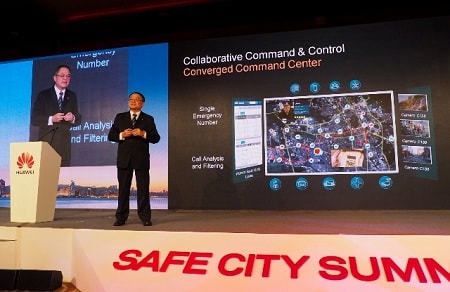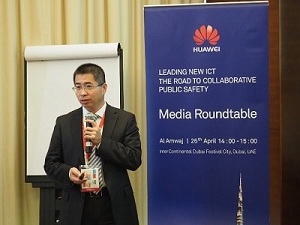Huawei hosted its Global Safe City Summit 2017 themed “Leading New ICT, The Road to Collaborative Public Safety” in Dubai from April 26-27. More than 350 government customers, industry experts, and partners participated in the summit to share their experience and opinions, and promote digital transformation of the public safety industry.
During the summit, Huawei introduced the C-C4ISR Collaborative Public Safety Solutions, which will drive digital transformation of the global public safety industry. Together with world-leading public safety partners such as YITU, SenseTime, Zenith, iOmniscient, and GSAFETY, Huawei also released the first all-cloud and matrix intelligence Video Cloud Solution and Crisis and Disaster Management Solution. The solutions are designed to address diverse safety threats and protect citizens in cities across the world.
With increasing global urbanization, cities are expanding and becoming less safe. Governments are increasingly focused on developing safe cities and aim to reshape urban public safety systems through innovative ICT. However, traditional siloed public safety systems typically lack information sharing capabilities and are major barriers to effective collaboration between different government agencies, which is essential for prevention of and response to emergency situations.
C-C4ISR Collaborative Public Safety Solutions will be the core of public safety systems
Commenting on public safety, Fan Siyong, President of Public Sector of Huawei Enterprise Business Group, said: “As cities embrace digital transformation, new safety threats are emerging that need to be addressed by the public safety industry. We need to keep pace with social and technological developments and shift from a traditional city safety construction model to one of collaborative public safety. By building cross-region and cross-agency collaborative public safety systems that connect governments and citizens, we can help cities better prevent, detect, handle, and recover from various threats. The ‘collaborative’ method of C-C4ISR will be fundamental to digital transformation of the public safety industry. Using new ICT such as Internet of Things (IoT), Big Data, mobile broadband, and Software-Defined Networking (SDN), as well as cloud-pipe-device synergy, the solution will drive efficient collaboration among governmental agencies as well as between governmental agencies and citizens.”
The Collaborative-C4ISR or C-C4ISR includes C-Command & Control, C-Communication, C-Cloud, cross-agent C-Intelligence based on Big Data, service-oriented C-Surveillance, and C-Reconnaissance leveraging numerous access technologies of various types of devices, such as IoT and drones. “Collaborative” is the core feature of the C-C4ISR, enabling crucial visualization and convergence to maximize public safety.
During the summit, Hong-Eng Koh, Global Chief Public Safety Expert of Huawei Enterprise Business Group, stated: “In today’s digital world, platforms and ecosystems are accelerating digital transformation of cities and changing the way people connect and communicate, such as using Facebook, Uber, and WeChat. In this new era, crimes and other threats are rapidly developing and public safety agencies need advanced technology that enables inter-agency collaboration to handle emerging threats and challenges. Huawei’s C-C4ISR platform and partner ecosystem are helping agencies to develop a collaborative public safety method that can help them maintain control over fast-changing situations.”

Huawei releases the first all-cloud and matrix intelligence Video Cloud Solution, supporting cross-region and network-wide sharing
Currently, social video and numerous public safety video systems are typically constructed independently, which results in a lack of data sharing and analysis between government agencies and regions. Cross-regional crimes are increasing and without a collaborative cross-region video solution, collecting and analyzing information consumes a significant amount of time, manpower, and costs, which is both inefficient and can delay a timely response.
Huawei is launching the first all-cloud Video Cloud Solution featuring distributed matrix intelligence. Cloud resource pools support global scheduling and flexible scaling, meeting cross-agency requirements and helping agencies better handle incidents. The solution integrates Big Data technology and can be applied in a variety of scenarios. Bai Jianhua, General Manager of Government Solution Department of Huawei Enterprise Business Group, said: “Based on an open cloud platform, the Video Cloud Solution can support partners’ various intelligent analysis algorithms and many practical video services. With matrix intelligence architecture design, the Video Cloud Solution provides distributed analysis capabilities at the center, edge, and frontend layers. This enables many functions, including local data storage, nearby computing, and automatic results connection and convergence. When cross-agency and cross-region tasks are delivered, the system can respond with analysis results in seconds, realizing data-driven ‘smartness’. Additionally, the Video Cloud Solution can provide various public services, such as the traffic guidance, crowd detection in scenic spots, and searching services for lost people, for other organizations and agencies.”

Crisis and Disaster Management Solution converges IoT and Big Data to deliver early warning capabilities
According to the United Nations’ statistical analysis , mortality and property losses caused by disasters and incidents is growing. Many factors, such as a lack of disaster assessment and preparedness, poor early warning capabilities, and lack of cross-agency collaborative command and dispatch, bring various challenges to crisis and disaster management. At the summit, Huawei shared how it has cooperated with industry-leading disaster management partner GSAFETY to release the Crisis and Disaster Management Solution integrating IoT and Big Data full-lifecycle for the first time. The solution builds the infrastructure platforms through front-end IoT perception, agile networks, and cloud-based data centers. The solution integrates many modules, such as intelligent surveillance, Big Data, IoT platform, critical communications, and converged command, to support the prevention, preparation, detection, warning, handling and rescue, and summary components of crisis and disaster management. This significantly improves government emergency departments’ practical capabilities, better protects human lives and properties from disasters, such as the typhoon, flood, and hazardous chemical leakage, and helps people take preventive measures.
With the “Openness, Collaboration, and Shared Success” principle of the Huawei Safe City Solution, Huawei is committed to closely cooperating with world-leading partners in many industries, such as consultation and planning, system integration, and software applications. Huawei works with partners to develop a mature Safe City ecosystem and build one-stop Safe City solutions. Nowadays, Huawei Safe City solutions have been serving about 800 million people in more than 200 cities of over 80 countries in multiple regions, such as Europe, Africa, and Asia Pacific.
For more information about the Huawei Global Safe City Summit 2017, visit http://e.huawei.com/topic/safe-city-2017-en/About-Summit.html




















